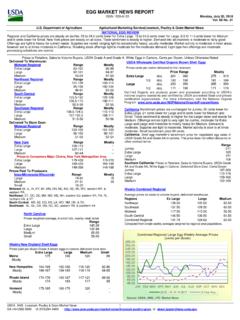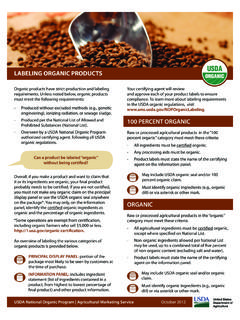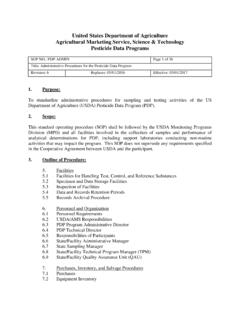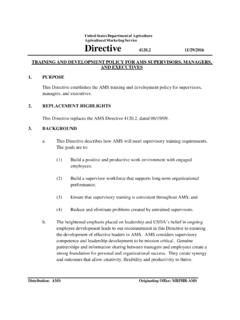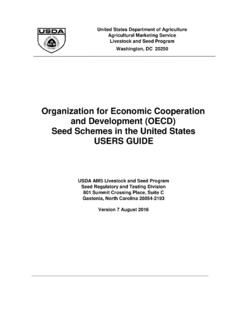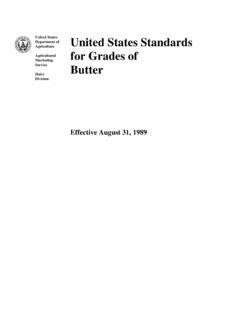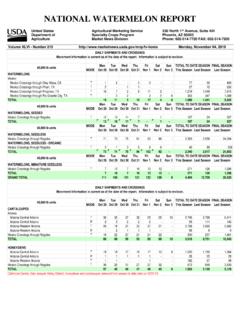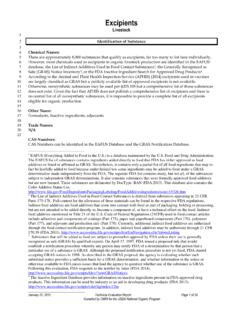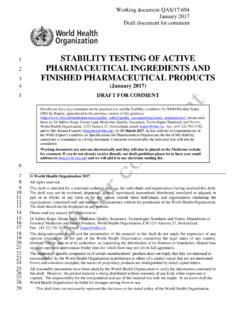Transcription of Draft Guidance Calculating the Percentage of Organic ...
1 United States Department of Agriculture 1400 Independence Avenue NOP 5037. Agricultural Marketing Service Room 2648-South Building Effective Date: December 5, 2016. National Organic Program Washington, DC 20250 Page 1 of 16. Draft Guidance Calculating the Percentage of Organic ingredients in Multi-Ingredient Products 1. Purpose and Scope The USDA Organic regulations establish labeling categories for Organic products based on the Percentage of Organic ingredients in the product. Products labeled Organic must have a minimum of 95% Organic ingredients , and those labeled made with Organic (specified ingredients or food group(s)) must have a minimum of 70% Organic ingredients . Products containing less than 70% Organic ingredients can list Organic ingredients on the ingredient panel as well as the Organic ingredient Percentage on the information panel, although they cannot claim Organic on the principal display panel. The USDA Organic regulations describe calculation of the Percentage of organically produced ingredients in Section Certifying agents have interpreted differently, leading to an inconsistent application of the regulations.
2 This Guidance clarifies the standards for Calculating Organic percentages for finished products to consistently implement USDA. regulations. This Guidance provides guidelines to all USDA-accredited certifying agents (certifiers) and certified and exempt Organic operations on how to calculate the Organic ingredient Percentage in multi-ingredient products. More specifically, this Guidance provides procedures on how to: 1) Calculate Organic percentages of multi-ingredient ingredients used in Organic processed products. 2) Determine the Organic content of single-ingredient ingredients (raw or processed). 3) Exclude water from ingredients used in Organic processed products. 4) Calculate the Organic content of carbonated beverages. 5) Exclude salt from ingredients used in Organic processed products. 2. Background The National Organic Standards Board (NOSB), a federal advisory committee that advises the USDA on Organic issues, made a recommendation related to the calculation of Organic percentages in multi-ingredient products in April 2013.
3 The NOSB recommendation asked the NOP to: 1) Correct the regulatory language at (a) to clarify that Organic percentages should be calculated by dividing the total net weight (excluding water and salt) of combined Organic ingredients at formulation by the total net weight (excluding water and salt) of all ingredients . The NOSB recommended that the Percentage of Organic ingredients in a product should be calculated based on the net weight of all ingredients in that product, and not the net weight of the finished product because most products lose weight during processing;. NOP 5037 Calculating the Percentage of Organic ingredients in Multi-Ingredient Products Authorized Distribution: Public United States Department of Agriculture 1400 Independence Avenue NOP 5037. Agricultural Marketing Service Room 2648-South Building Effective Date: December 5, 2016. National Organic Program Washington, DC 20250 Page 2 of 16. 2) Clarify how to calculate the Organic percentages of a multi-ingredient product that contains ingredients that are themselves composed of more than one ingredient.
4 3) Clarify when to exclude salt and water from ingredients ;. 4) Provide Guidance on how to calculate raw agricultural product and processed single- ingredient ingredients ; and to 5) Develop and publish example self- Calculating forms on items related to the Organic Percentage of each ingredient and the exclusion of salt and water. This Guidance addresses this NOSB recommendation. The scope of this Guidance does not cover how the use of sanitizers or other materials affects the 100% Organic labeling claim. 3. Policy and Procedure : Calculating the Organic content of multi-ingredient ingredients and products Formulated multi-ingredient certified Organic products often contain Organic ingredients that are themselves composed of multiple ingredients . Section (a)(1) states the method of calculation as [d]ividing the total net weight (excluding water and salt) of combined Organic ingredients at formulation by the total weight (excluding water and salt) of the finished product.
5 [Emphasis added.] To accurately calculate the Organic Percentage , it is necessary to divide the total net weight (excluding water and salt) of combined Organic ingredients at formulation by the total weight (excluding water and salt) of all ingredients . : Certified Organic or Made with Organic ingredients that are themselves composed of multiple ingredients For products that have ingredients composed of multiple ingredients (also referred to as multi- ingredient ingredients ), the exact Organic content should be obtained of that multi-ingredient ingredient when Calculating the total Organic content of the final Organic product. Alternatively, these ingredients should be calculated as contributing either 95% Organic content or 70% Organic content depending on how the product is classified on the certificate ( , either Organic or made with Organic (specified ingredients or food groups) respectively). If the multi-ingredient ingredient used in a product formulation is to be counted as contributing more than 95% or more than 70% Organic ingredients (depending on the certification classification of the product).
6 Certified Organic handlers should: Calculate the multi-ingredient ingredients by breaking them down into their constituent parts to distinguish between the Organic and non- Organic content of the ingredient. The calculation will account for the real Organic constituents in the product. Provide their certifier with supporting documentation (for example, written confirmation from the certified Organic supplier of the multi-ingredient ingredient) that substantiates the Organic content claim of a multi-ingredient ingredient. NOP 5037 Calculating the Percentage of Organic ingredients in Multi-Ingredient Products Authorized Distribution: Public United States Department of Agriculture 1400 Independence Avenue NOP 5037. Agricultural Marketing Service Room 2648-South Building Effective Date: December 5, 2016. National Organic Program Washington, DC 20250 Page 3 of 16. : Added Water and Salt The percentages of water and salt added during the manufacture of the ingredient, and that remain in the ingredient, should be disclosed by the Organic ingredient supplier.
7 Certified operations must keep records to demonstrate to their certifier that the final product calculations supplied to the certifier have excluded the relevant salt/water from incoming Organic ingredients . However, when water is listed as an ingredient of an FDA recognized standardized food and that product is used as an ingredient in a multi-ingredient food, the water does not have to be disclosed by the Organic ingredient supplier and does not need to be excluded when Calculating the Percentage of organically produced ingredients . : Organic Claim vs Organic Content As specified in , the Organic content or Percentage of an ingredient or product is based on the Percentage of Organic ingredients . Processing aids are not ingredients ; therefore they should not impact the Organic ingredient Percentage of an ingredient/product. The use of a non- Organic processing aid prevents the ingredient/product from being labeled as 100% Organic , but if the Organic ingredient/product is composed of 100% Organic ingredients , it can be calculated as contributing 100% Organic content when it is used in a multi-ingredient Organic product.
8 See Appendix A for an example calculation for a multi-ingredient product that contains multi- ingredient ingredients , water and salt. : Calculating the Organic content of single-ingredient ingredients , processed or raw : Processed single ingredients Processed single-ingredient ingredients (excluding added water and/or salt) can be determined by handlers, manufacturers and certifiers to contribute 100% Organic content in a multi-ingredient formulation, even if they are listed as Organic on a certificate. An example is sugar, which is processed with calcium hydroxide as a processing aid. The exception is for single-ingredient ingredients that are processed according to the NOP but the ingredient is significantly different from the raw condition (refer to for a link to the definition of raw agricultural commodity). Examples include, but are not limited to: Organic glycerin where Organic oils are processed with materials on the National List and a new product is produced, which would still contain a portion of non- Organic material.
9 Or Sliced Organic apples that have been dipped in a solution composed of materials on In these cases, handlers should obtain verification from the ingredient supplier regarding the ingredient's Organic content unless the Organic certificate for the ingredient identifies it as 100% Organic .. NOP 5037 Calculating the Percentage of Organic ingredients in Multi-Ingredient Products Authorized Distribution: Public United States Department of Agriculture 1400 Independence Avenue NOP 5037. Agricultural Marketing Service Room 2648-South Building Effective Date: December 5, 2016. National Organic Program Washington, DC 20250 Page 4 of 16. : Single ingredients that are raw agricultural commodities 1. Raw agricultural ingredients can be determined by handlers, manufacturers and certifiers to contribute 100% Organic content in a multi-ingredient formulation, even if they are listed as Organic on a certificate. : When to include or exclude water from the Organic calculation for specific ingredients The following Guidance applies to products that contain added water, specifically, juices, multi- ingredient formulations such as chicken stock, soy beverages, almond beverages, rice beverages, ready to drink tea/coffee products, or products containing those ingredients .
10 Juices with an FDA Standard of Identity The USDA Organic regulations at (a)(2), state [i]f the liquid product is identified on the principal display panel or information panel as being reconstituted from concentrates, the calculation should be made on the basis of single-strength concentrations of the ingredients and finished product. In order to ascertain the single strength juice value of a concentrate, the FDA. regulations can be consulted at 21 CFR (h)(1), which provides a table stating the minimum brix 2 levels for various single strength juices. This table is a tool for Calculating the quantity of water that can be added to Organic juice concentrates to bring them to single strength. This water is considered a part of the Organic content of the juice product. See Appendix B for an example calculation of Organic juice, when the specific fruit/vegetable juice has a standard of identity and the single strength brix is listed at 21 CFR (h)(1).
